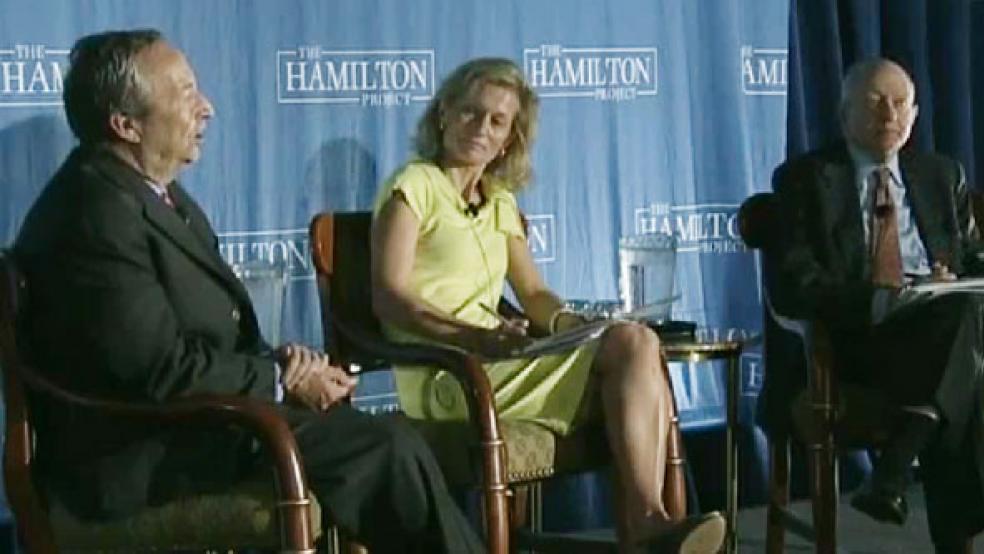One of the biggest challenges confronting lawmakers and the White House in cutting rates and reforming the tax code is eliminating many of the costly deductions and write offs in the code to help offset the cost over the overhaul.
Eliminating popular and long-standing provisions such as the tax deductions on mortgage interest, employer-provided health insurance and savings in IRAs and 401(k)s would almost certainly spark a backlash from voters and special interest groups.
Martin Feldstein, the Harvard economics professor and former Chairman of the Council of Economic Advisers, touted a novel solution for avoiding those political headaches at a Washington conference on Thursday: Keep all 200 or so of the tax deductions in place but cap the amount that anyone can claim at 2 percent of their adjusted gross income.
“You can say [to taxpayers] keep all of the tax expenditures that you have – all of the deductions -- but you just can’t be too greedy about it,” Feldstein said during a tax-reform conference today sponsored by the Brookings Institution’s Hamilton Project.
Feldstein’s approach would generate an estimated $278 billion to $300 billion a year in fresh tax revenue. By comparison, the House-passed GOP budget and tax-cut plan would cost the Treasury on average $460 billion a year of foregone revenue or $4.6 trillion over the coming decade, according to the urban-Brookings Tax Policy Center. The $120 billion shortfall would likely result in additional budget cuts.
“So If you add up all the benefit that you get from the tax expenditures, multiplied by your marginal tax rate, and limit it to 2 percent of AGI, anything in excess of the 2 percent you don’t get as a deduction or exclusion, that raises a lot of revenue, that will move a lot of people into the standard deduction rather than itemizing – which is great simplification,” Feldstein told The Fiscal Times.
The roughly 200 tax deductions and refundable tax credits currently on the books will cost the government as much as $1.3 trillion in foregone revenues this year, according to Treasury estimates. In the past, there have been many recommendations to reduce or eliminate specific deductions or so-called “tax expenditures,” but singling out a handful of them for elimination strikes many as unfair. Under his approach, Feldstein said, “You don’t have to pick and choose” which tax deductions are preserved and which are eliminated.
Among the biggest tax deductions with huge political constituencies are these:
• Tax-free employer-provided health care and other health spending constitutes the single largest tax expenditure: $214 billion a year.
• Retirement savings, including IRAs and 401(k) programs: $206 billion annually.
• Mortgage interest deductions on homes and second homes: $113 billion a year.
• Preferential rates on capital gains and dividends: $91 billion.
• State and local income, property and sales tax deductions: $84 billion.
• Earned income, child and dependent care tax credits: $76 billion.
Feldstein’s novel approach was first outlined in a Tax Notes analysis written a year ago by Feldstein, Daniel Feenberg of the National Bureau of Economic Research and Maya MacGuineas, the director of the fiscal policy program at the New America Foundation.
A two percent cap on tax deductions would have reduced the fiscal 2-11 deficit by $278 billion, or about 1.8 percent of the projected gross domestic product, according to the study. An important advantage of the 2 percent cap is that it causes a substantial simplification for more than 35 million taxpayers who are persuaded by the cap to shift from itemizing their deductions to using the standard deduction – a major simplification of the tax system.
Tax reform is a battle cry of both parties in a key election year. But how and when to try to overhaul the federal tax code – and pay for it without adding to the $15 trillion national debt -- is the overarching and perplexing questions hanging over Congress and the White House. Republicans and some moderate Democrats are discussing approaches that would simultaneously cut the top individual and corporate tax rate of 35 percent to 25 percent and eliminate taxes on the foreign profits of U.S. based multinationals, while “broadening the tax base” by doing away with many of the existing tax deductions.
Lawrence H. Summers, the former Obama Administration Treasury Secretary who appeared at the Brookings conference, said he would be in favor of base broadening, but cautioned that from a strategic standpoint, “You are better off attacking deductions and exclusions as a group than you are trying to decide which ones to go after.”
Summers, who returned to Harvard last year to teach, said that in overhauling the scores of tax deductions, including those covering charitable giving, the system must be made more equitable or progressive. “I think with respect to most of them, but not all of them, that there is an oddity that if affluent individual gives a dollar to charity he gets 35 cents back, and if a middle-income individual gives money to charity he gets a 15-cent deduction. So I would for the most part favor the conversion of deductions to credits and then some limitations on the deductions. How you do that remains a technical means, but I would be very much in support of base broadening.”




